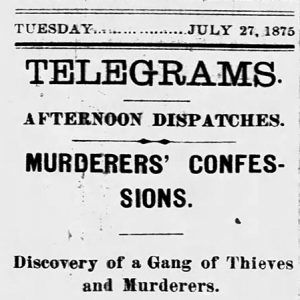calsfoundation@cals.org
John Randolph (Lynching of)
On July 22, 1875, an African American man named John Randolph was shot by unknown men at Cowell’s Landing (Mississippi County). Randolph and another man were accused of the robbery and murder of Frank Williams, a German man who worked on a plantation named Dickenson’s Mills, which was owned by A. K. Hancock and located on Frenchman’s Bayou forty miles above Memphis, Tennessee.
While the Arkansas Gazette published a story datelined Memphis on July 26, a July 31 story in the Osceola Times contained more complete and presumably more accurate information. According to the Times, on Monday, July 19, Williams was paid and then started out for the Shawnee Village landing, located on a plantation of that name owned by Dr. F. G. McGavock, where he intended to catch the steamer to Memphis. That same night, Hancock’s storehouse was broken into and robbed. When the theft was discovered the next morning, it was also discovered that two African American men named John Randolph and John or “Cy” Phillips, who were workers on the plantation, were also missing, and they were immediately suspected of the crime. A white man named Robert Burton, who also lived and worked on the plantation, saw the two and asked Constable John DeSpain to take them into custody so that he could go and get a warrant. By the time Burton returned, the two had escaped. Hancock himself then got a warrant, and a search was initiated. At the same time, it was learned that Williams, last seen at Shawnee Village at 8:00 a.m. on the morning of July 20, had not, in fact, managed to catch a boat.
The flight of Randolph and Phillips, coupled with the disappearance of Williams, led Hancock to suspect foul play. According to the Osceola Times, Hancock discovered that Randolph and Phillips had bought on old dugout from someone near the landing, and he got a skiff and followed them down the river. He saw a dugout on the shore of Island No. 40, and as he approached, he saw the two escapees talking with a group of other men. They ran off, but Hancock pursued them and shot at them. Randolph surrendered, and Phillips was soon captured. Both denied having murdered Frank Williams.
That night, Hancock took them to Dickenson’s Mills, where they were brought before a magistrate’s court and arraigned for robbery. Phillips told the magistrate privately that Williams was dead and he and Randolph knew where his body was, but did not confess to the murder. Randolph admitted to belonging to the group and reported that he and Phillips, along with another African American named Jesse Carter and an unidentified white man, had joined a band organized by Robert Burton for the purpose of robbing and murdering, if necessary, “every man in the country who had over ten dollars.” Hancock was to be their first victim, but this plan failed because they lacked the right ammunition for their pistol. Learning that Williams had been paid, they decided to target him instead. They followed him to Shawnee Village, but as it was too busy for their purposes, they offered to show Williams a path to Cotton-Wood-Point where he could catch an earlier boat. They stopped to rest on the edge of a backwater on McGavock’s land, and when Williams bent over to tie his shoe, they hit him over the head. He was only stunned and told them to take his money and go. Not wanting to leave a witness to their crime, they beat him to death and robbed him. They then threw his body into the water. They told the magistrate that they knew where the body was and that they would take authorities there. A group led by the magistrate then took Phillips to the site, where they found Williams’s body and the club used in the attack. The men then went back to Dickenson’s Mills, where Randolph and Phillips were put under a strong guard.
In the meantime, Hancock set out for Shawnee Village to find Burton. He found him in a house there, and when Burton came out, Hancock pulled a pistol. Burton surrendered, and they went back to Dickenson’s Mills, where he joined Randolph and Phillips and Jesse Carter, who had just been arrested. By this time, a large crowd had assembled. On Thursday, July 22, Burton and Carter said they would waive extradition and asked to be taken to the jail in Osceola. Around nightfall, a deputy sheriff and a guard, which included Hancock, set out for Cowell’s Landing to catch a steamer. They suspected they were being followed, but the journey was uneventful. When they arrived, they built a fire, and Hancock went to rest in a nearby warehouse. After the prisoners had been tied up for the evening, someone shot Randolph and Phillips, who fell into the fire. Guards pulled them out of the fire, but Randolph was badly wounded. Fearing that their pursuers had caught up with them, the guards prepared for a fight, but none ensued. Soon, however, they heard noises as if someone were attempting to stampede their horses. When some of them went to investigate, a group of men ran past the remaining guard and seized Randolph and Phillips, who reportedly then confessed to the murder. Gunshots were heard from the woods, and the guards who went to investigate found Randolph’s body and threw it into the river. The guards and their remaining two prisoners spent the night in fear at the camp, and in the morning Burton and Carter were taken to Osceola and jailed. The additional white man in the group was never identified, and had not been arrested.
Although the assumption was that Phillips had also been shot, this was not the case. According to the August 7 edition of the Osceola Times, Phillips was captured and taken to jail in Osceola on July 31. He apparently fell when he and Randolph were fleeing through the woods, and his pursuers either thought he was dead or ran out of bullets, and ran past him. The next day, he reportedly set off toward Osceola to surrender but saw a group of armed men looking for him and ran, getting lost in the woods. Deputy Sheriff S. A. Beal organized a search party, and they pursued him for several days. He was eventually captured near Dead Timber Lake and jailed in Osceola. Authorities hoped that the final member of the robbery band would be captured so that all of the members of the group could be punished. According to the Times, “Mississippi [C]ounty has already too long labored under the opprobrium of lenity with which the laws are executed within her borders. We are sadly in need of reform in that particular, and malefactors should be made to know and feel that…the guilty must suffer for all mis-deeds.”
For additional information:
“Murder and Lynch Law.” Osceola Times, July 31, 1875, p. 2.
“Murderer’s Confessions.” Arkansas Daily Gazette, July 27, 1875, p. 3.
Untitled. Osceola Times, August 7, 1875, p. 3.
Nancy Snell Griffith
Davidson, North Carolina
 Civil Rights and Social Change
Civil Rights and Social Change Post-Reconstruction through the Gilded Age, 1875 through 1900
Post-Reconstruction through the Gilded Age, 1875 through 1900 John Randolph Lynching Article
John Randolph Lynching Article 



Comments
No comments on this entry yet.